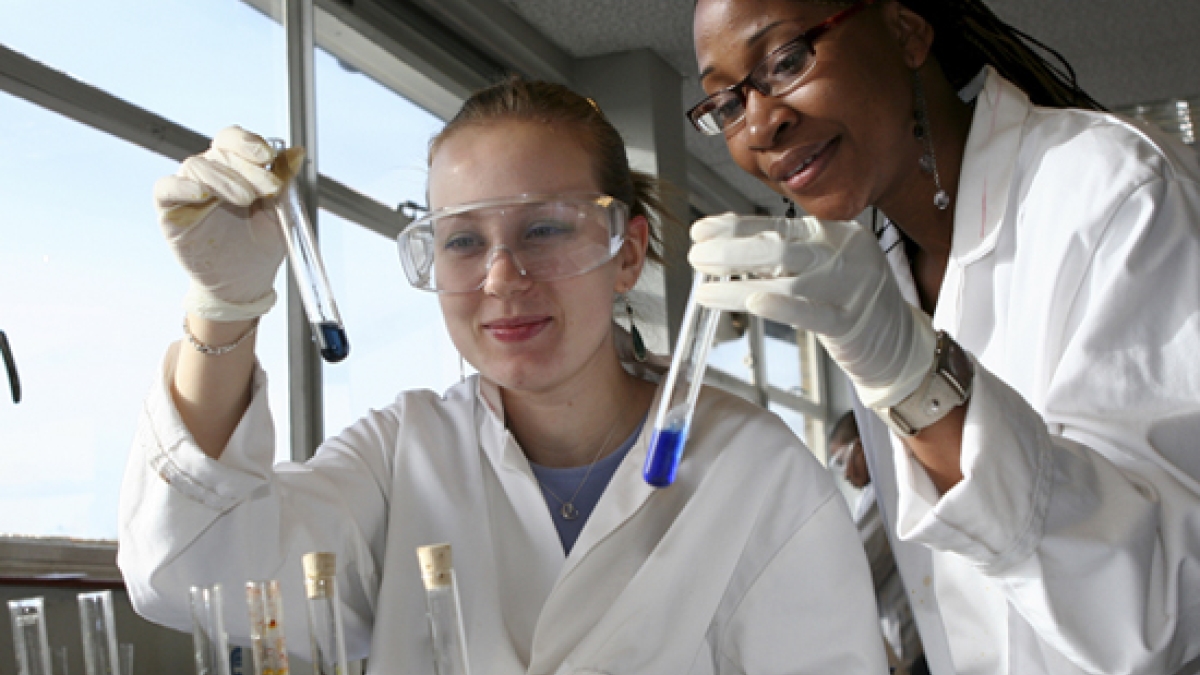Green Labs: Cutting costs and carbon emissions

Bubbling algae and beakers brimming with emerald-colored liquids no longer represent the only green materials found in the more than 1,200 laboratories across all four of ASU’s campuses. The Green Labs program, directed by ASU’s department of Environmental Health and Safety (EH&S) and partners from Office of University Sustainability Practices, ensures that day-to-day functions occurring within the nearly 1.5 million square feet of lab space are now enhanced with environmentally mindful practices and procedures.
The average ASU lab size is about 1,250 square feet, and the Tempe campus is home to approximately 1.1 million square feet of lab space. Lab activities include everything from laser and radiation use to chemical and biological procedures as well as geotechnical and material testing operations.
“Labs are the most-energy intensive spaces on campus, which makes resource conservation and energy efficiency to be of significant importance in supporting ASU’s sustainability goals of carbon neutrality; zero water/solid waste; active engagement; and principled practice,” says Michael Ochs, assistant director, ASU Occupational Safety & Health.
It’s estimated that laboratories use three to eight times the energy of comparable-sized office buildings. Sometimes labs operate on a 24/7 cycle, creating higher electrical energy use from a variety of frequently used lab equipment such as sterilization instruments like autoclaves and ventilation equipment such as fume hoods.
Some ASU labs have been on a greener path since before the spring 2011 Green Labs program launch. For instance, Ochs was part of the ASU-APS Energy Services team that identified which ASU fume hoods needed to be retrofitted with devices that reduce energy use and maintain lab-worker safety. According to Ochs, when labs undergo annual lab-safety registrations, it’s the perfect time to go green through the Green Labs self-assessment certification process, which includes the following goals:
- Energy and resource conservation
- Waste reduction
- Idea sharing and collaboration
- Training and awareness
- Chemical sharing and alternatives
To realize one of the program’s goals, lab researchers and the EH&S hazardous waste unit teamed up to establish the ASU laboratory glass recycling program, a pioneering effort, according to Ochs.
Green Labs also encourages sharing and exchanging unused portions of hazardous chemicals as well as using alternative and safer materials in place of hazardous materials.
“When conducting operations, safer and environmentally friendly chemical alternatives may be found that will perform identically as the original chemical, but may be disposed as non-hazardous waste,” says Dave Jaggers, EH&S asbestos and environmental safety specialist. “When making initial chemical purchases, the hope is that labs evaluate all processes and consider the possible waste that may be created.”
To foster communications among ASU labs, Green Labs orientations are open to anyone interested in joining the program and will be held monthly during fall 2011 on all four ASU campuses. Participants can enroll through ASU’s Learning Management System by searching for: Green Office And Labs Orientation. These one-hour meetings include a brief Green Labs history, how to establish lab goals, and time for questions and suggestions.
“One of our very first objectives we hope to achieve is to generate inter-activity among the lab groups,” Jaggers says. “The sessions hopefully will instill a sense of empowerment for lab employees to become engaged and to take ownership of sustainability efforts in the areas where they work.”
Representatives from EH&S and Office of University Sustainability Practices lead the sessions, ensuring that communication continues between the groups and also that the Green Labs program remains on track with ASU’s larger sustainability objectives.
“Both of our missions are so closely aligned,” says Jehnifer Niklas, program coordinator for the Office of University Sustainability Practices. “Through adapting or adopting proven practices that reduce our ecological footprint and our bottom line, together we can create a healthy, vivacious working environment in which researchers can thrive.”
Like-minded colleagues who shared a vision of cost-effective and sustainability conscious labs is how Green Labs got its start. In 2008, EH&S hosted a national webinar that was delivered by Alan Doyle, who then was the sustainability coordinator at the University of California Santa Barbara. The session, “Green Laboratories: Resource Conservation in Research Settings” kick started a professional relationship between Doyle and Ochs, who together shaped some of the webinar’s commonsensical principles into the Green Labs program.
The program was designed with a lot of flexibility, so that an ASU lab group can create its own sustainability goals and strategies to find cost-saving methods and to reduce carbon emissions. During 2010 and 2011, Ochs presented Green Labs to the university safety compliance officers consisting of more than 100 ASU employees from all departments.
As Green Labs develops, suggestions, trends, feedback and labs’ individual fiscal and sustainability goals will be tracked and considered to determine ways that it can be improved. According to Ochs, the program’s refinement process is aligned with ASU’s model of the university functioning as a living laboratory.
In the continued spirit of camaraderie, EH&S is slated to deliver a Green Labs presentation and host a tri-university Arizona conference in October 2011 that includes partners from the University of Arizona and Northern Arizona University.
“In partnership with other universities leading similar green labs programs, we founded the national Green Labs Planning Group to provide resources to other lab groups so they can practice sustainable principals in their own labs,” Ochs says.